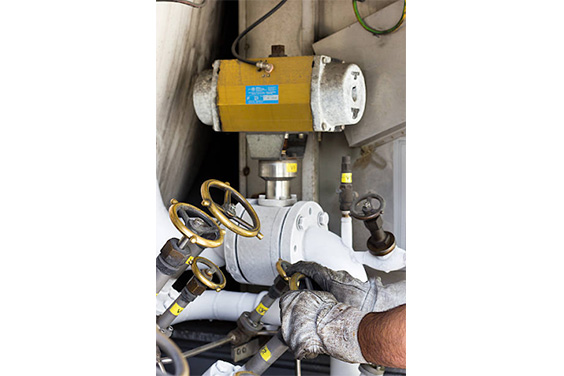Industries that handle cryogens, and extremely low-temperature and high-pressure fluids employ cryogenic valves to transport and store these fluids. Cryogenic valves are a special type of valves that are built specifically to handle extreme temperature and pressure conditions. To ensure a cryogenic valve’s reliability, cryogenic testing of valves is done.
Cryogenic valves are commonly employed in LNG, petrochemical, food processing, air separation, and many other industries. The ability of these valves to carry low-temperature fluids helps them find applications in several fields. Cryogenic valves are manufactured with the right materials to ensure that they can withstand chemicals while simultaneously tolerating temperature and pressure conditions.
What is Cryogenic Testing of Valves?

Cryogenic testing of valves refers to the process of checking a cryogenic valve for leakage below certain temperature levels. Testing of cryogenic valves is usually done using liquid nitrogen; a few other standard tests include pressure testing and valve cavity origin. This is one of the standard tests that cryogenic valve manufacturers employ to make sure that the manufactured valves withstand extreme temperatures.
An industrial valve manufacturer that focuses on the production of cryogenic valves will ensure that proper testing and quality checking methods are followed strictly. A faulty valve, especially a malfunctioning cryogenic valve, can lead to severe damage because these valves primarily carry chemicals. Leakage of such chemicals can be a hazard and create unwanted situations.
Following the right cryogenic test procedure during production helps reduce accidents. Cryogenic valves undergo various types of tests that determine their quality. Here are some of the standard tests:
- Shell Strength Test
This test is conducted to test the strength of the valve and the amount of pressure it can withstand. A valve is mounted on a tabletop in partially open condition and then it is subjected to hydrostatic pressure. The amount of pressure to be applied to the valve depends on the material of the valve; this test follows the API STD 598 standard.
- Seat Leak Test
This test follows after the shell strength test. It is employed to determine the amount of leakage in a valve at a particular pressure and temperature. The procedures for this test are followed according to ASME B16.34 and API STD 598.
The valve is mounted on the test table in a fully closed position. Hydrostatic pressure is applied through one of the openings of the valves and the amount of leakage is tested at the other opening.
- Cryogenic Production Test
This cryogenic test procedure is followed according to the standards and procedures outlined in BS 6364 – an established standard for cryogenic valve testing. There are several rules and regulations covered by this specific standard. It details the design, material, strength, and other crucial characteristics of a cryogenic valve.
- Cryogenic Testing of Valves using Liquid Nitrogen
Liquid nitrogen is injected into a cryogenic valve to test its temperature tolerance. The liquid nitrogen is slowly introduced to the valve placed in a cryogenic tank – once the required pressure and temperature are achieved, the valve is examined for any external or internal leaks. Sniffers, manometers, and thermocouples are employed in this test.
ISO Standards
There are specific ISO standards that guide the production of cryogenic valves – these standards are established to ensure that the high quality of these valves is preserved and to avoid any potential leakage. The ISO 21011:2008 standard specifies the characteristic requirements of a cryogenic valve in terms of design, manufacturing, and testing. A valve manufacturing industry must follow all these rules and regulations so that the safety of the users is not compromised.
It applies to all types of cryogenic valves – the only exception is the pressure relief valves that are covered under a different ISO standard.
Application of Cryogenic Valves
Cryogenic valves find applications in many industries because of their special characteristics. For example, the transportation and storage of LNG can only be done with the help of cryogenic pipelines and valves.

Here are a few industries that involve the usage of cryogenic valves:
- Food and Beverage Industry: These industries often involve procedures that need low-temperature fluids to be transported and stored inside factories and cryogenic valves are extremely useful here.
- Oil and Gas Industry: Liquefied Natural Gas is primarily handled through cryogenic pipes and valves. If the gasses are not maintained at the right temperature and pressure, they might expand and cause an explosion.
- Medical Industry: Transmission of liquid oxygen is done through cryogenic pipes and valves.
- Aerospace Storage: Cryogenic valves are very common in the aerospace industry as they are used in turbines and storage spaces.
- Petrochemical Industry: Cryogenic valves play a crucial role in the petrochemical industry – the transportation of petrochemical products and chemicals is done through cryogenic valves as they need to be preserved at the right temperature and pressure levels.
Why is Cryogenic Testing of Valves Important?
Employing cryogenic tests for valves is a basic necessity as these valves will be used in certain temperature conditions that demand tolerance from these valves. For the peak performance of a cryogenic valve, it should be scrutinized thoroughly to ensure that there are no faults with it.
It is estimated that over 60% of the valves manufactured in an industry do not pass the basic quality tests assigned for cryogenic valves. Leakage problems and broken shells are found more often, and these faulty valves cannot be used because they are hazardous. This is why cryogenic valves need to go through many levels of testing in terms of temperature, pressure, and mechanical damage.
Conclusion
Industrial valve manufacturers need to ensure that valves are manufactured according to the standards and guidelines established by organizations like ISO and ASME. The same applies to cryogenic valves, the type of valves that carry and store low-temperature fluids. Cryogenic testing of valves can be done on several levels and among them, the liquid nitrogen test and shell strength test are very important.
If you are looking for a quality cryogenic cum industrial valve supplier, DomBor is the perfect choice for you. All our industrial valves are manufactured according to established standards and we also employ many levels of quality checks. Contact us today and get customized cryogenic valves as per your requirements.









